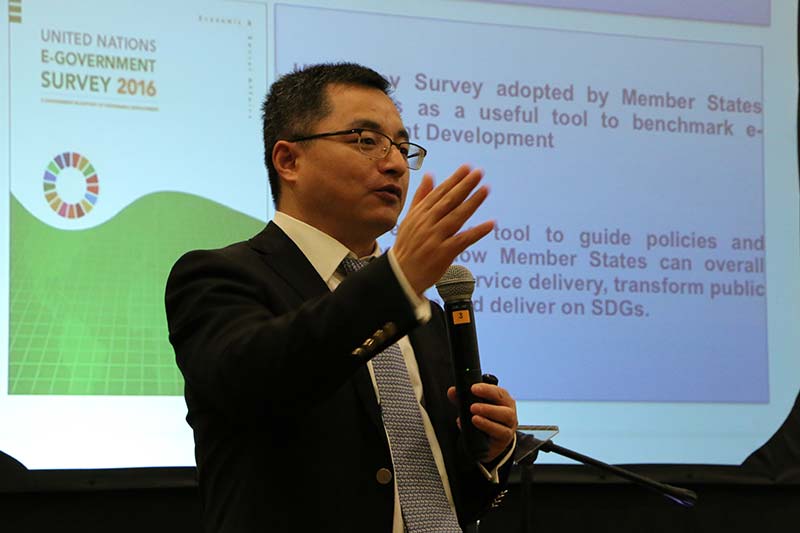
OpenGov attended a presentation on the UN E-government Survey by Yao Keping, Governance and Public Administration Officer, United Nations Department of Economic and Social Affairs (UNDESA), United Nations to senior ICT exectuives from the Malaysian government , in Kuala Lumpur last week. As part of its 2030 agenda for sustainable development, the United Nations (UN) has set 17 development goals. At number 16 in the list is ‘Peace, justice and strong institutions’. Evaluating the performance of a country on this means looking at the indicators for government. The Division for Public Administration and Development Management (DPADM), which is a division of the UNDESA assists countries on transformative governance and innovative public administration in advancing sustainable development. DPADM adopts a cyclical, integrated approach consisting of normative work and support for intergovernmental processes, advocacy and knowledge transfer on good governance, capacity-building and advisory and partnership building. To accomplish the above, one of the core areas of focus is ICT. Within ICT, the UNDESA’s work revolves around e-government, open government data and the Action lines set by the World Summit on the Information Society (WSIS). The last includes leveraging ICT for development and the role of public governance in that. Since, being launched in 2001, the biannual UN E-government survey has become an important benchmark for member states to track their performance and identify their weaknesses, with regards to the use of ICT for transforming and reforming the public sector by enhancing efficiency, effectiveness, transparency, accountability, access to public services and citizen participating. 106 out of 193 member countries were part of the 2016 survey and 6 key ministries were looked at.
It is the most comprehensive survey of its kind, in terms of geographical coverage. For the 2016 survey, 96 online volunteers, with knowledge of 66 languages from 59 countries were involved. This helped to look at government websites in native languages, which often offer more content than the English language versions.
The original questionnaire is not shared with the participating countries, as work design could be modified with a view to scoring higher, without corresponding improvement in services. This occurs because of an inherent limitation of the survey. It has to focus on the supply side of the services, because resources are not as easily available to evaluating adoption and usage. Usage is looked at but information is limited.
Mr. Yao cautioned that the results should not be taken as an absolute measure. It is a relative measure and a country’s drop in rankings would usually indicate faster progress by others, rather than backsliding in the country in question.
The methodological framework has been consistent but components were updated in the 2016 survey to reflect new trends in g-government and new indicators were added for telecommunications and human capital. Going forward, UNDESA is revisiting the framework to align it better with the Sustainable Development Goal (SDG) framework. While making changes, Mr. Yao said a degree of consistency has to be maintained to ensure comparability between the surveys. Member states could be included in the re-designing process as co-creators. Methodology A country’s ranking in the survey is determined by the EGDI, which is a weighted average of three normalized scores on 1. Scope and quality of online services (Online Service Index, OSI)2. Development status of telecommunication infrastructure (Telecommunication Infrastructure Index, TII)3. Inherent human capital (Human Capital Index, HCI). The OSI is based on a four-stage model, indicating the state’s online presence. The lowest level is ‘Emerging’ where the state merely provides basic information online, while the highest called ‘Connected’ reflects Whole-of-government (W-o-G) approach and G2G, G2C and C2G connectivity. The two intermediate stages are ‘Enhanced’ (e-tools, e-information, e-services) and ‘Transactional’ (Two-way interactive applications, financial and non-financial transactions). The national website in the native language, including the national portal, e-services portal and e-participation portal, as well as the websites of the related ministries of education, labour, social services, health, finance and environment as applicable are assessed.

Source: https://publicadministration.un.org/egovkb/Portals/egovkb/Documents/un/2016-Survey/Annexes.pdf The survey also derives an e-participation index (EPI), as a supplementary index. It is to measure citizens’ participation in public decision-making. E-Participation Framework is made up of E-information, E-consultation and E-decision-making.
Thematic areas of the 2016 survey
- Whole-of-Government (W-o-G) approach – Service delivery, policy integration and institutional coordination: Mr. Yao said a high level of integration is required within the government. Government alone cannot achieve the SDGs. So, the involvement of other stakeholders, including civic society is required. In 2014, Collaborative government was the term used. There is not a big difference between the meanings.There is a trend towards providing integrated public service through one-stop platforms. As of 2016, 98 countries were requiring digital ID for these online or mobile public services. That is an important step towards integration.
- Open government data – This was also present in 2014. But within the theme, the survey considers how open data can be combined with big data analytics to enable predictive actions, moving from reactive to pro-active approach. 128 countries are currently providing datasets on government spending in machine readable formats. 106 countries had open data catalogues in 2016, compared with only 46 countries in 2014.
- E-participation – This is one of the old themes, which has been present in several past editions. It tries to measure the key shift in government’s role from being an information provider to engaging citizens for consultation and decision-making. Citizen involvement in service design is also looked at. Leveraging social media and sourcing open source code solutions could be innovative ways of improving e-participation and empowering individual citizens.
- Multi-channel service delivery - This old theme looks at the digital divide, mobile services and usage uptake, with an increased stress on the last, compared to previous editions. In a sluggish global economy, it becomes imperative to show the return-on-investment for digital government services. Adoption by citizens is key in that regard. Mobile devices have high penetration even in relatively poorer countries, making it a crucial channel for digital transformation at the grassroots level. Mr. Yao gave the example of M-PESA which allows users to perform monetary transactions using money stored in an account stored on their cellphones.
- Innovative partnerships through use of ICT – This refers to things like crowdsourcing or partnerships with the private sector, providing new engines of digital transformation. The private
Selected data from the 2016 surveySource: DPADM, UNDESA One of the core findings of the 2016 survey was that E-government has shifted over the past 15 years from a staged process to non-sequential, overlapping and connected building blocks. This is reflected in the increasing adoption of agile development and integrated service delivery platforms.

N/a indicates that the feature was not included in that year’s survey. The second and third points were removed from the 2016 survey as the first criteria of a one-stop-shop makes those two redundant. A good example would be the Gov.UK portal. Instead of assessing the features, the outcome is looked at. The portal should guide citizens to whichever service they need. They should not have to negotiate the often-labyrinthine hierarchy and complexities of the structure of public sector agencies and departments. Digital ID is connected to the one-stop-shops, as it can the means of access for the citizens. The big spike during 2014 to 2016 is in the number of nations incorporating security features in their digital services. Mr. Yao explained that security features are important for first-time users who do not have much knowledge of how government websites or online services operate. Robust security will help in promoting the usage of the digital services and engender trust in the public.
Mr. Yao said that based on their experience political leadership, political will from the top level is the most important factor for developing successful e-governance. There has to be a central agency, which brings together different ministries and enables them to talk to each other. When they talk to each other, their databases can also interact and services can be integrated. The position of the Chief Information Officer or an equivalent (CIO) can be the proxy for assessing that.


Government spending appears to be the one attracting most attention from citizens. Currently, 9 countries in Asia including Japan, Republic of Korea, Singapore and India in 5 or more of the above key sectors. Australia and New Zealand also meet this benchmark. However, the survey currently is not looking at the quality of the data. Around 50% of countries provide tools to obtain raw public opinion and 38% pr
ovide guidance for using Open Government Data, while only 24% have a Data Dictionary, providing the precise meanings of each data set.
“The more you use Open Data, the more value you can create. Then citizens will demand greater access and the government seeing the benefits, will release more data. It is a virtuous cycle,” Mr. Yao said explaining the assessment of Open Data usage tools.
As countries realise the benefits of using ICT to deliver services, more and more of them are adopting the same. 46% of member states were classified at Very High or High level of the Online Service Index (OSI) in 2016, compared to 33% in 2014. Mr. Yao said that there is a strong correlation between the degree of centralization of data and the OSI rating, as the former enables efficient e-service delivery.
Looking at the trends in online transactional services between 2014 and 2016, there was a sharp jump in the number of countries offering personal accounts for citizens, from 101 to 142. Citizens are demanding a greater amount of customized, intelligent services to meet the unique needs of each individual or family’s needs. Another big jump during the period was in countries offering online channel for registering businesses. It increased from 60 to 97. As economies struggle to grow, governments want to encourage citizens, especially the younger generation, to start their own businesses. Ease of registering businesses would be key to that.
During the past two years, another movement was towards increasing adoption of mobile platforms for service delivery.

Though the Republic of Korea has consistently been ranked in the top 3, they are revisiting and revamping everything, benchmarking themselves against the best and using new tools provided by new technology. They plan to move over 60% of e-gov services to the public cloud by 2017. It is a process of continuous improvement. No country can afford to sit on their laurels. That would mean falling behind.
















